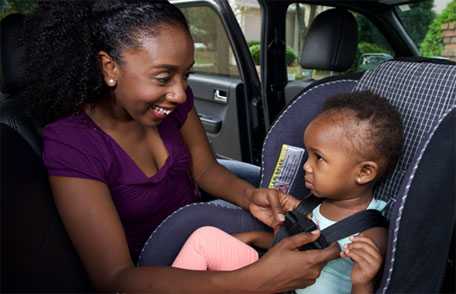Child Passenger Safety

National Child Passenger Safety Week is September 17-23. Make sure the ones you love are safely buckled up in the car on every trip.
Reduce Their Risk
In the United States, motor vehicle crashes are a leading cause of death among children. In 2015 , 663 children ages 12 years and younger died in motor vehicle traffic crashes, and nearly 132,000 were injured. But parents and caregivers can make a lifesaving difference.
Whenever you’re on the road, make sure children are buckled in age- and size-appropriate car seats, booster seats, or seat belts. Children under age 13 should ride properly buckled in the back seat on every trip. Never place a rear-facing car seat in the front seat or in front of an airbag. Airbags can kill young children riding in the front seat.
Data shows that:
- In 2015 , restraint use saved the lives of 266 children ages 4 years and younger.
- Car seats reduce the risk of death in car crashes by 71% for infants and 54% for toddlers ages 1 to 4.
- Booster seats reduce the risk for serious injury by 45% for children ages 4 to 8 years.
- Between 1975 and 2015 , child restraints saved an estimated 10,940 lives of children ages 4 and younger.
As part of National Child Passenger Safety Week, September 23rd is National Seat Check Saturday, when drivers with child passengers are encouraged to visit a child safety seat inspection station to have a certified technician inspect their car seat and give hands-on advice free of charge. Locate a car seat inspection station in your area.

Make sure children are always properly buckled in the back seat in a car seat, booster seat, or seat belt, whichever is appropriate for their age, height, and weight.
Know the Stages
Make sure children are properly buckled up in a car seat, booster seat, or seat belt, whichever is appropriate for their age, height, and weight.
- Birth up to age 2 – Rear-facing car seat. For the best possible protection, infants and children should be buckled in a rear-facing car seat, in the back seat, until age 2 or when they reach the upper weight or height limits of their particular seat. Check the seat’s owner’s manual and/or labels on the seat for weight and height limits.
- Age 2 up to at least age 5 – Forward-facing car seat. When children outgrow their rear-facing seats they should be buckled in a forward-facing car seat, in the back seat, until at least age 5 or when they reach the upper weight or height limit of their particular seat. Check the seat’s owner’s manual and/or labels on the seat for weight and height limits.
- Age 5 up until seat belts fit properly – Booster seat. Once children outgrow their forward-facing seat (by reaching the upper height or weight limit of their seat), they should be buckled in a belt positioning booster seat until seat belts fit properly. Seat belts fit properly when the lap belt lays across the upper thighs (not the stomach) and the shoulder belt lays across the chest (not the neck). Remember to keep children properly buckled in the back seat for the best possible protection.
- Once seat belts fit properly without a booster seat – Children no longer need to use a booster seat once seat belts fit them properly. Seat belts fit properly when the lap belt lays across the upper thighs (not the stomach) and the shoulder belt lays across the chest (not the neck). For the best possible protection keep children properly buckled in the back seat.
- Install and use car seats and booster seats according to the seat’s owner’s manual or get help installing them from a certified Child Passenger Safety Technician. Find a Child Passenger Safety Technician.
Buckle all children ages 12 and under in the back seat. Airbags can kill young children riding in the front seat. Never place a rear-facing car seat in front of an airbag.
- Buckle children in the middle of the back seat when possible, because it is the safest spot in the vehicle.
- Buckle children in car seats, booster seats, or seat belts on every trip, no matter how short.
- Set a good example by always using your seat belt.

More Information
More Information
- Morbidity and Mortality Weekly Report (MMWR) Announcement on Child Passenger Safety Week
- National Child Passenger Safety Week
- CDC Vital Signs: Child Passenger Safety: Buckle up every age, every trip
- Child Passenger Safety: Information and Resources
- Protect the Ones You Love from Road Traffic Injuries
- Task Force on Community Preventive Services and the Community Guide: Motor Vehicle Occupant Safety
- CDC National Action Plan for Child Injury Prevention
- CDC Childhood Injury Report
- National Highway Traffic Safety Administration: Child Safety
- American Academy of Pediatrics Child Passenger Safety Policy Statement
- American Academy of Pediatrics Child Passenger Safety Technical Report
Podcasts on Child Passenger Safety
- Page last reviewed: September 18, 2017
- Page last updated: September 18, 2017
- Content source:
- National Center for Injury Prevention and Control
- Page maintained by: Office of the Associate Director for Communication, Digital Media Branch, Division of Public Affairs




 ShareCompartir
ShareCompartir